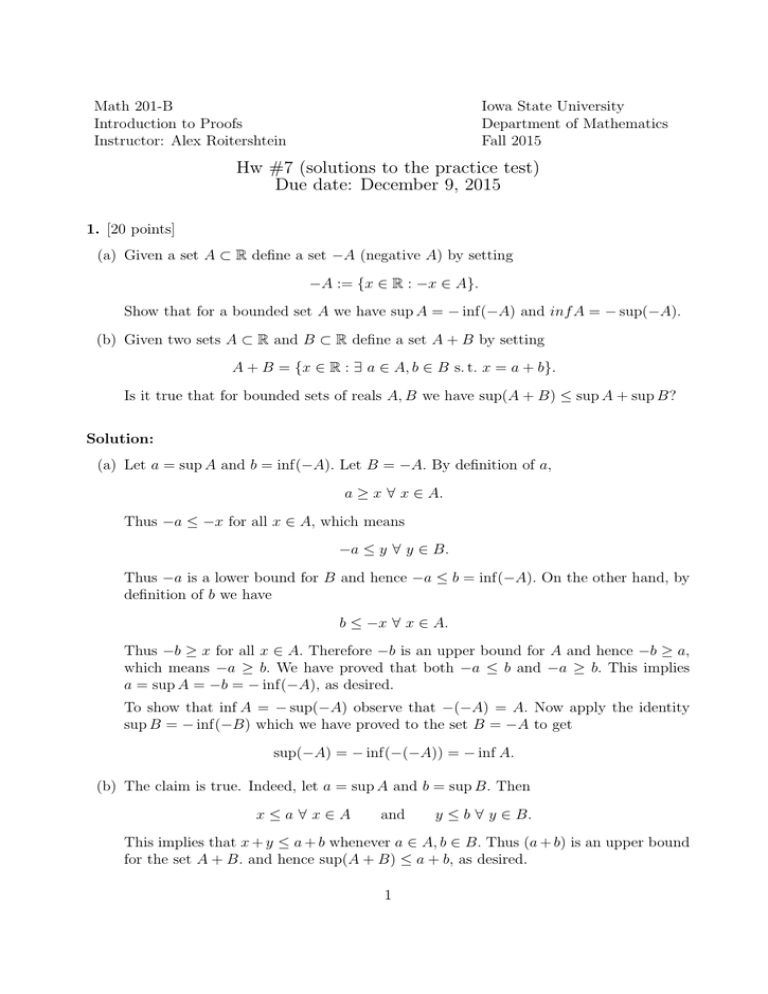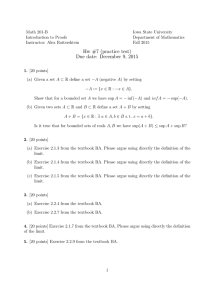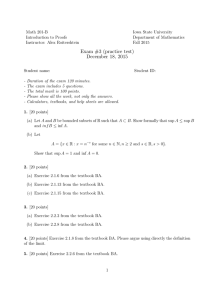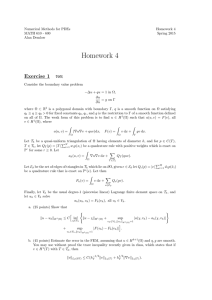Math 201-B Iowa State University Introduction to Proofs Department of Mathematics
advertisement

Math 201-B
Introduction to Proofs
Instructor: Alex Roitershtein
Iowa State University
Department of Mathematics
Fall 2015
Hw #7 (solutions to the practice test)
Due date: December 9, 2015
1. [20 points]
(a) Given a set A ⊂ R define a set −A (negative A) by setting
−A := {x ∈ R : −x ∈ A}.
Show that for a bounded set A we have sup A = − inf(−A) and inf A = − sup(−A).
(b) Given two sets A ⊂ R and B ⊂ R define a set A + B by setting
A + B = {x ∈ R : ∃ a ∈ A, b ∈ B s. t. x = a + b}.
Is it true that for bounded sets of reals A, B we have sup(A + B) ≤ sup A + sup B?
Solution:
(a) Let a = sup A and b = inf(−A). Let B = −A. By definition of a,
a ≥ x ∀ x ∈ A.
Thus −a ≤ −x for all x ∈ A, which means
−a ≤ y ∀ y ∈ B.
Thus −a is a lower bound for B and hence −a ≤ b = inf(−A). On the other hand, by
definition of b we have
b ≤ −x ∀ x ∈ A.
Thus −b ≥ x for all x ∈ A. Therefore −b is an upper bound for A and hence −b ≥ a,
which means −a ≥ b. We have proved that both −a ≤ b and −a ≥ b. This implies
a = sup A = −b = − inf(−A), as desired.
To show that inf A = − sup(−A) observe that −(−A) = A. Now apply the identity
sup B = − inf(−B) which we have proved to the set B = −A to get
sup(−A) = − inf(−(−A)) = − inf A.
(b) The claim is true. Indeed, let a = sup A and b = sup B. Then
x≤a∀x∈A
and
y ≤ b ∀ y ∈ B.
This implies that x + y ≤ a + b whenever a ∈ A, b ∈ B. Thus (a + b) is an upper bound
for the set A + B. and hence sup(A + B) ≤ a + b, as desired.
1
2. [20 points]
(a) Exercise 2.1.3 from the textbook BA. Please argue using directly the definition of the
limit.
(b) Exercise 2.1.4 from the textbook BA. Please argue using directly the definition of the
limit.
(c) Exercise 2.1.5 from the textbook BA. Please argue using directly the definition of the
limit.
Solution:
(a) Fix any ε > 0. For all n > (2ε)−1 we have
(−1)n
1
− 0 =
< ε.
2n
2n
Thus limn→∞
(−1)n
2n
= 0.
(b) Fix any ε > 0. For all n >
− log ε
log 2
we have
|2−n − 0| = 2−n < ε.
Thus limn→∞ 2−n = 0.
(c) Fix any ε > 0. For all n > ε−1 − 1 we have
n
1
−
1
< ε.
=
n+1
n+1
Thus limn→∞
n
n+1
= 1.
3. [20 points]
(a) Exercise 2.2.4 from the textbook BA.
(b) Exercise 2.2.7 from the textbook BA.
Solution:
(a) Since xn+1 = x2n , if the limit L = limn→∞ xn exists, it satisfies the equation
L = L2 .
Thus L ∈ {0, 1}. Notice that if xn ∈ (0, 1) then xn+1 < xn . Hence, by induction, xn is
a decreasing sequence. Since x0 = 1/2, we obtain that L = 0.
2
(b) False. Counterexample: xn = (−1)n .
4. [20 points] Exercise 2.1.7 from the textbook BA. Please argue using directly the definition
of the limit.
Solution:
(a) The claim follows directly from the definition of the limit and the identity
|xn − 0| = |xn | − 0 = |xn |.
(b) For instance, x2n = −5 + n−1 , x2n+1 = 5 + n−1 .
5. [20 points] Exercise 2.2.9 from the textbook BA.
Solution: Pick any ε.0 such that ε < L and L + ε < 1. By definition of the limit, for all n
large enough we have
L−ε<
|xn+1 − x|
<L+ε
|xn − x|
In particular, |xn+1 − x| < (L + ε)|xn − x| < |xn − x|. Thus yn = |xn − x| is a bounded from
below decreasing sequence. Thus there exists
a = lim |xn − x|.
n→∞
But unless a = 0, we have
|xn+1 − x|
a
= = 1,
n→∞ |xn − x|
a
lim
contradicting the assumption that L < 1. Hence a = 0. By definition of the limit this implies
limn→∞ xn = x.
3









